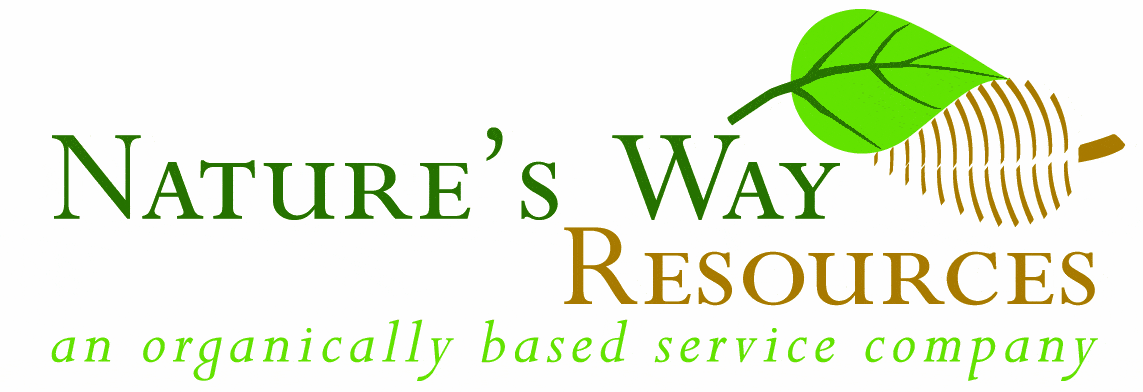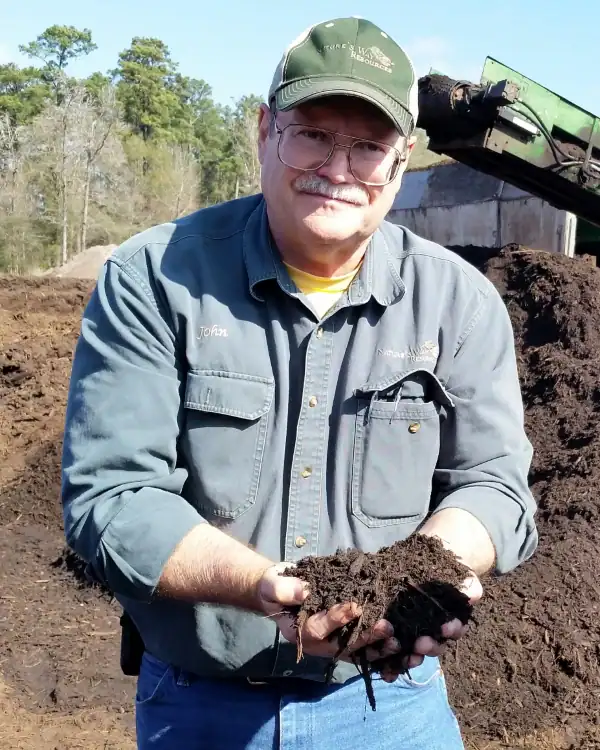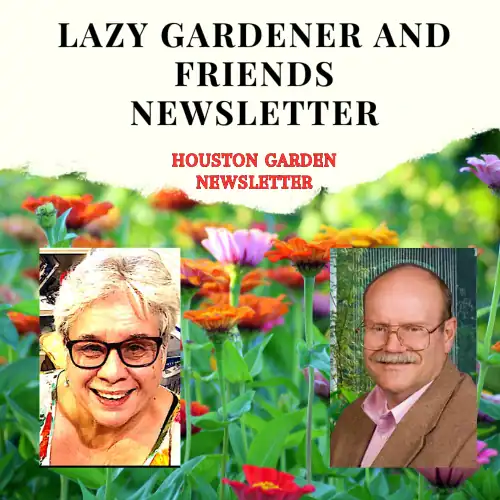
Nature’s Way Resources is proud to produce & email you this free weekly newsletter. We have no ads, but sponsors do graciously help support this project as a public service. Please note their names below & show your gratitude for this free service by patronizing their businesses! To become a sponsor, call (936) 273-1200
Nature’s Way Resources owner John Ferguson, “The Lazy Gardener” Brenda Beust Smith, and Shelby Cassano welcome your feedback and are so grateful to the many horticulturists who contribute their expertise
“White at night creates ‘to die for’ backyard”
BY BRENDA BEUST SMITH (aka The Lazy Gardener)

White flowers absolutely glow at night! L to r: Shasta daisies, roses, and
moonflowers. Have others that work well in Houston?
Email to lazygardenerbrenda@gmail.com
IT’S ALMOST SEPTEMBER which — to folks ‘nawth’ of us — means fiery fall color seldom seen here. Fret not! Most think only of trees, but tons of fall color decorates other plants as well.
Texas’ six very distinctive zones can be very different. Safer to check your growing zones first. HUGE difference when investing in trees.
Did the East Asia-native Chinese tallow (Triadica sebifera) immediately come to mind? DON’T DO IT! This unwelcome-albeit-gorgeous fall-colored tree is VERY invasive here. It can (and does) emit chemicals fatal to other plants to make room for its own seedlings. Texas A&M’s AUTUMN COLORS page is a treasure trove of recommendations WITH pros/cons. Fascinating reading (including great fall tree color learning-activities for children).
THANKS TO READERS who responded to last week’s gardening safety tips, so adding more from folks in the know. Especially love longtime contributor Doris Heard‘s tip (also makes an easier carrier!):
- “A large plastic pail with a lid makes a perfect seat for weeding—it’s just the right height and surprisingly comfortable. Doubles as storage for weeding tools – my favorite is a small serrated knife which does a great job of removing roots.”
JOYCE M. in Waller was awed at how much gardening seems easier after a friend urged her to “warm up” first. Gardening often strains our lesser-used parts! Gentle neck rolls, shoulder rolls, arm circles, side bends, gentle leg stretches and walking-in-place for just a few minutes each prepares oft-less used muscles for what’s coming. You’ll move better and hurt less later on!
LILLEY JONES in Sugarland widened spaces between garden areas that need tending so she can use her golf cart to get around! (Makes a handy tool carrier too.) She also had her hose holder and water spigot attached higher than usual on a wall to reduce bending down.
* Note to Readers & Greater Houston Area Master Gardeners — Would love to share fall color shrubs and/or flower recommendations for your specific area. Email (w/pictures if you have!) to lazygardenrbrenda@gmail.com.
It’s almost “FALL” – – at least calendar terms, tho when it starts depends on whom you ask! Meteorologists say “Fall” starts Sept 1. Climatologists say Sept. 22. Why? Meteorology is the scientific study of the atmosphere and short-term weather patterns. Climatology is the scientific study of climate, which includes (long-term patterns of temperature, precipitation, wind, and other atmospheric conditions). Who else would tell you these things?
Bottom line (especially in Houston!): it’s what we’re feeling that matters, and anyone who tries to stuff long-term Houston weather predictions into established boxes is, well …
More to the point in our gardens: Ever take into consideration the way colors — even in the garden — affect our mindsets? (These apply to all color use — not just in gardens)
- Red, yellow, and hot pink make us energetic. (Reds increase appetite!)
- Yellows make us happy. Also, the first and easiest to see. (See below)
- Soft pinks, lavenders, blues, and greens soothe, relax.
- Pink looks sweet and fragrant (even if not!). It’s said it’s hard to argue with someone in pink!
- Green is restful, especially on tired eyes.
- Blues and lavenders are cooling.
COLORS can also trick eye-perspectives!
- To make a small yard look bigger, plant “hot” colors (red, orange, fuchsia) close in. In back of the yard, use pastels and white (they look farther away than actually are).
- To make a too-large area look more intimate, do the reverse: “hot” colors in the back of the yard and pastels close in.
- For eye-popping front yard displays, use yellow, hot pink, fire engine red and white. These are easier to see from a passing car than lavender and muted red or pink will be. (Remember when selling a house!)
- Use lower-growing yellow flowers around uneven pathways where folks might trip. Yellows and oranges draw the eye faster than any other color. (Which may be one reason why two of my favorite gardeners, the late Dr. Charles Squire and his wife Sally (aka “The Bulb Lady” in eras past), used to plant zinnias and marigolds in their front yard every spring..
- When possible, coordinate garden and house colors. When gardens adjacent to the house “just don’t look right,” color clashes may be to blame.
- White and/or gray flowers or foliage with colors help create harmony. White also intensifies colors of nearby flowers and plants.
- Use white flowers/foliage around areas used in evenings when white is all you can see.
(Above tips from my “Lazy Gardener Guide,” now available only as pdf. Free, email request to lazygardenerbrenda@gmail.com)
MORE TIPS:
- In areas of blasting hot sun (such as near water), pale pastels often become washed out. Stronger colors work better.
- Variegated plants may look like they’re dying if used all alone. Strong solid greens, reds,oranges, yellows, etc., may compete better.
- Color has a much greater impact when coupled with hardscapes (rocks, birdbaths, fences, benches, etc.).
- Large rocks pull us back to nature by anchoring us to Mother Earth. Their strength offers sort of a metaphysical protection from the stresses of everyday life. Locate at least one large interesting rock somewhere near the site where you sit outside at night.
- NEXT WEEK: More tips on using plants to make area look bigger, more intimate, etc.
* * *

ATTN. GARDEN/PLANT GROUPS
— Nature’s Way Resources offers free guided tours of NWR’s extensive nursery/soil/mulch facilities for garden clubs, plant societies and other plant-oriented, organized groups. As usual, NWR’s now-expanded meeting site is free to above groups. Reservations a must for both. Great time to visit.

Submitting a Calendar Event?
For best chance of getting it in next upcoming newsletter, submit in exact requested format (see top of calendar below. Reformatting by us may = delay in publication)
* * *

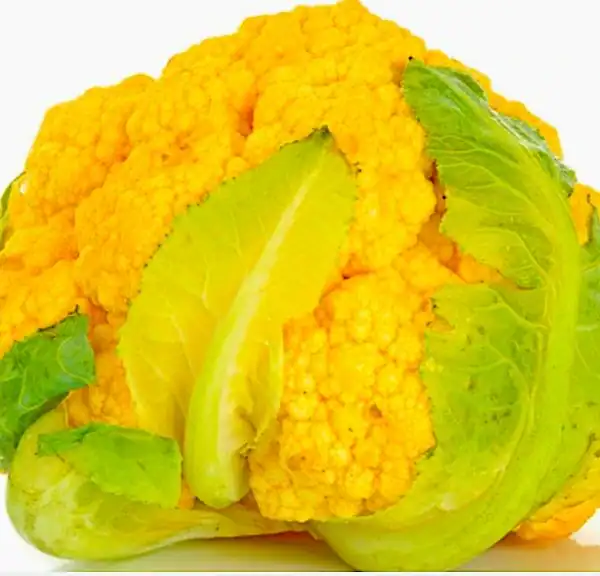
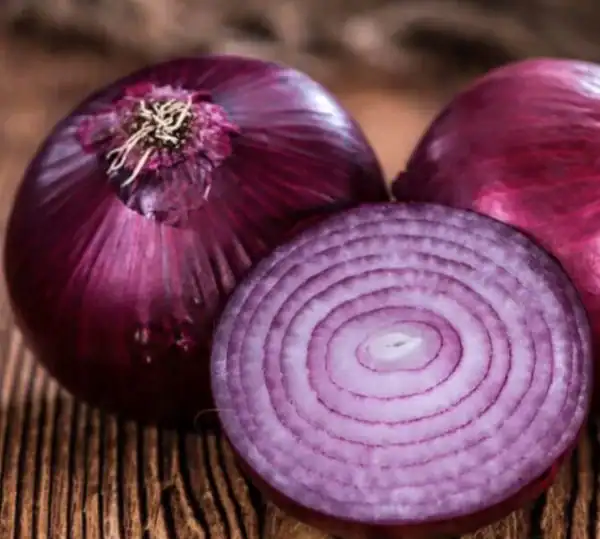
‘FLAME STAR’ CAUILFLOWER & RED CREOLE ONIONS BRING FALL SMILES!
By ROZ MORRIS
Edible Grow Leader
Mercer Arboretum & Botanic Gardens
friendsofmercer.com
Upcoming cool weather season has folks at Mercer excited about growing a cole crop called the ‘Flame Star’ Cauliflower (Brassica oleracea var. botrytis ‘Flame Star’). The Flame Star is an orange cauliflower with 25% more beta-carotene than traditional white cauliflower. Vitamin A (beta-carotene) helps maintain healthy vision, keep bones and teeth strong, and reduce cancer risks. The orange cauliflower is heat tolerant, and planting this variety in full sun during the Fall season helps intensify the color. The orange cauliflower plant does not need blanching (pulling the leaves over the head to keep the sun from dulling the color of the curd). And the taste of this variety is sweeter and nuttier than traditional cauliflower. Harvesting is a quick 60-80 days to maturity. And a fun fact, the Flame Star will retain its color while cooking, which means when the temperatures get chilly; I can enjoy homemade orange cauliflower soup, and receive the extra health benefits. Sounds like a win-win to me.
Another exciting cool season crop is the Red Creole onion (Allium cepa ‘Red Creole’). This variety is a perfect short-day onion for southern climates. The Red Creole onion will mature into a 3-4 inch globe shaped, dark, yet vibrant red-skinned onion ready for harvest in 100 days. The Red Creole onion flavor profile is spicy and bold, which when sliced is delicious when eaten raw on burgers. It also has a sweet flavor when caramelized and pickled. The moisture content is high which means it does not supposedly store as well as the yellow and the white onion, but the taste is so delicious it’s often always eat them first, so hard to confirm that fact!
* * *
Fall is the Most Productive Season
for Growing Vegetables in Greater Houston
By ANGELA CHANDLER
The Garden Academy
Fall gardening stands out as the most productive season in the Houston area because it offers some unique advantages not available in other seasons — milder temperatures, more consistent moisture, reduced plant stress and lower pest & disease pressure. But one of the most distinct advantages is the variety of food crops that will grow over this season.
Houston’s summer “feels like” temperature is often much higher than the thermometer indicates. This is hard on our gardens, for certain, but it also on gardeners. The difference between daytime highs and evening lows can be quite small, giving plants little relief, even at night, stunting growth and causing premature bolting. Milder temperatures and cooler evenings alleviate these stresses and encourage steadier, healthier growth.
Many common pest threats diminish as temperatures drop. Fungal diseases become less prevalent, rain is more frequent rain and less evaporation after irrigation. Soil remains warm enough for germination of many seeds but not baked as often find during tsummer.
Wth timing and a little good luck, we can often get in a second crop of warm season crops like squash, cucumbers, and beans. And start first planting of our cool season crops (cabbage, broccoli, spinach, and greens of all kinds). Best start these indoors starting in mid-August for planting out in September. Root crops soon follow, and we can often harvest something every week from now through spring.
Fall tomatoes are an all-time favorite with many Houston area gardeners and our local nurseries respond with a healthy variety to choose from. We often harvest tomatoes all the way to Christmas by keeping some row cover on hand for the few really cold nights.
John’s Corner
NEWS FROM THE WONDERFUL WORLD OF SOIL AND PLANTS
#343
Subject: How Mulches Go Bad
Something most of us do not think about is Fire Danger from our mulch. We talked about a couple of them over the last couple weeks. We are coming up on the season when fires are in fireplaces, fire pits, barbecue pits, and many other possible sources.
Over the last few years, there have been a lot of wildfires in the USA and thousands of homes destroyed (ex., Bastrop, Texas, 2011). Fires in California and Canada this past year, to name a few.
In many cases, it was not the roof that caught fire, but the mulch in the landscape.
The mulch ignited and then carried the fire to the house.
Often, mulch is set on fire by still-burning embers from forest or grass fires brought in by the wind. Cigarettes are a common ignition source, lightning is a possible source, static electricity, and even broken bottles can focus the sunlight and cause a fire.
Known Fire Ignition Sources
- Cigarettes
- Sparks (fireplace, bar-b-que pit, fire pit)
- Embers (burning house or wildfire)
- Lightning
- Static Electricity
- Wiring (electrical shorts)
- Reflected heat from low-E windows
- Matches and lighters
- Broken bottles
- Spontaneous
- Sparks from accidents
How often do we see scenes like this where cigarettes are dumped on a highly flammable mulch? This shredded mulch was a very poor choice since it is near a smoking area.
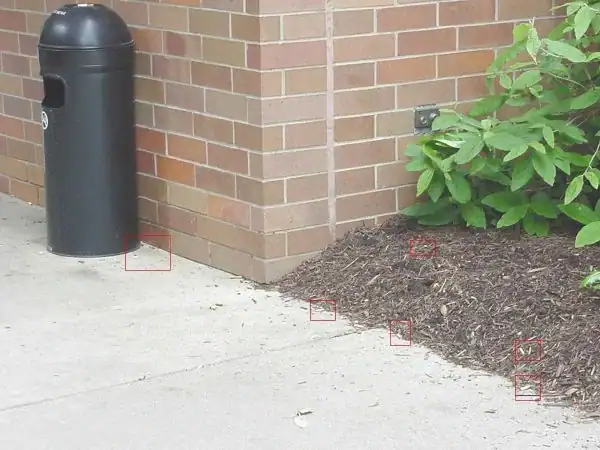
Below is an example of how an ember could catch the easily flammable dyed mulch on fire, which could then catch the fence on fire and travel to the house.
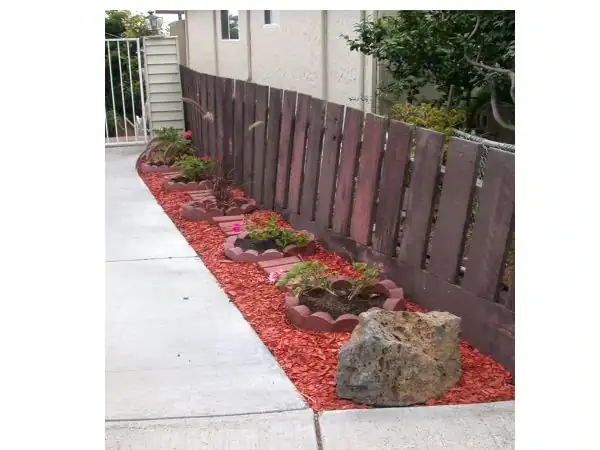
As a result of all the homes that were burned, several universities decided to study the flammability of mulches and how they might contribute to house fires.
The researchers used a Propane Torch and applied fifteen seconds of intense heat and flame to each of the mulch samples, then the torch was removed. The tests were performed one year after installation of the mulch to match real-world conditions.
Some of the things that were discovered were surprising, as even some of the organic mulches would not ignite.
Just using a match (no propane torch), the ignition of Rubber Chipped Mulch occurred every time.
Fire in chipped rubber mulch, which is made from recycled tires, gave off toxic fumes, could not be extinguished with water (water spreads the flames and makes it worse). It required extinguishing by beating out with a shovel or special chemical foams that are toxic themselves.
Tests from the demonstrations found that the Dyed and Shredded Hardwood Mulch caught fire every time. The chart below lists the other results.
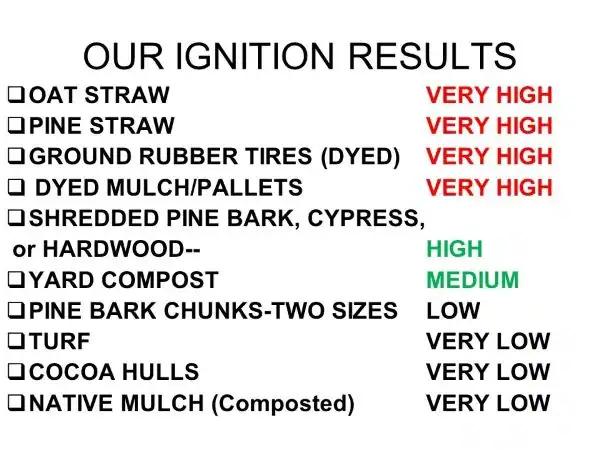
Some of the slides and data were from studies on mulch and fire conducted by the University of Nebraska and the University of Florida.
The next type of bad mulch occurs when it is not handled properly. I often hear folks commenting that the mulch they had purchased “stinks”. When mulch is placed in large piles, it compresses and becomes anaerobic from reduced airflow. Then the pile becomes very anaerobic and odorous.
Hence, odors are warning signs of low-quality and potentially dangerous mulches and composts. If these materials are not handled correctly during processing, they can become odorous.
1) Anaerobic organic acids that have a strong odor from the putrefying organic matter. The odor varies depending on feedstock or material and what is going on; however, they are all very bad. Plant roots are very sensitive to alcohols; as little as 1 ppm will kill most plant roots. A few common acids (odors) are:
Acetic acid – vinegar smell, loss of nitrogen and phosphorus, alcohols present
Butyric acid – sour milk smell, alcohols present
Valeric acid – vomit smell, alcohols present
Putrescine – rotting meat smell, alcohols present
2) Ammonia – implies an immature compost or mulch which will be phytotoxic (kill plants), and the nitrogen is being lost to the air.
3) Rotten egg (H2S) – implies an immature compost or mulch which is phytotoxic and signals a loss of the nutrient sulfur (S).
A third source of a bad mulch may occur from storm cleanup companies. During the cleanup following Hurricane Ike, I visited several of the FEMA sites where debris was being ground up into mulch by the contractors. In Texas, an authorized organic waste recycling company (legal) for mulch is not allowed to accept treated wood, creosote, etc., or painted wood. However, at the FEMA sites I witnessed contractors grinding up old railroad ties (creosote-treated, wood that is carcinogenic), fence posts and rails that were CCA-treated wood (copper, chromium, and arsenic), along with painted wood from old houses (lead), along with the brush and tree material into mulch.
Occasionally, during a tropical storm like Hurricane Ike, weak or damaged trees are the first to be blown down. Some common diseases of these weakened trees are Verticillium wilt, which is caused by a soil-borne fungus resulting in the decline or death of many shrubs and trees. Rhizoctonia solani is another plant pathogen that is stimulated by fresh mulches as it feeds off the cellulose in the wood. If diseased trees are ground up and used for mulch, it is possible that these diseases can spread to mulched plants.
The next possible mulch that may cause problems in the garden is plastic mulches. If not used properly, the black polyethylene roll-type plastic mulches often look bad, absorb excessive heat (if not covered by an organic mulch), essentially cooking the root systems of most plants. In wet years, the plastic often traps too much moisture in the root zone, drowning plant roots and creating a breeding ground for disease. The perforated types often only work as a weed block if installed in a certain way, and most need a large overlap of material to prevent roots/weeds from growing between layers. Also, the use of plastic mulches creates indirect and hidden costs to society related to environmental issues, the direct cost of removal, collection, and waste disposal. Recent studies have found that while plastic mulches help to obtain higher yields earlier in the season than bare ground, total yields over the entire season are often higher from bare ground.
As plastic mulch ages, it becomes brittle and starts breaking into smaller pieces. Over the last couple of years, we have begun to learn about the dangers of these microplastics and the health problems they cause.
Always go look at mulch before you order. Sometimes people have a visual image in their mind about what they want, and very frequently they use terminology incorrectly. Also, in different areas of the country, words and terminology are used differently. As a result, consumers will place an order, only to be disappointed in the results when it is delivered.
Also, many dealers and producers will use incorrect or misleading terminology. Some suppliers/dirt yards sell products that use words like “Black” and “Humus” in their names. These products are often made from fresh pine bark fines, do not contain any humus, and are chemically burned to turn them black by adding very alkaline chemicals (i.e., it is mixed with boiler ash, which is alkaline and contains high levels of salts). Other dealers will grind up old pallets, scrap wood, trees, etc., and mix it with fly ash or bottom ash, then sell it as a black hardwood mulch. These type products are very poor mulch choices and are often toxic to many plants. People use them, but when the plants get sick and die, they think, “I just do not have a green thumb.” People buy them because they are often sold at bargain prices…but they are not very cost-effective.
Another type of mulch that we seldom see in our area is mulch from mowed grass. Research from the USDA has found that if hairy vetch was killed with glyphosate (active ingredient in Round-Up TM) and then cut and used as a mulch, yields in some plants were reduced by 50% (HortScience, December 1997). Research at Michigan State University (published in same issue of HortScience) has found significant growth reduction on ornamental plants using pesticide-treated grass clippings as a mulch, with post-emergent herbicides causing the most damage. It has been learned that most herbicides do not break down as previously believed; hence, we should not use mulch made from plants or grass treated with herbicides (or pesticides and fungicides). Research at North Carolina State University has shown that herbicide-treated grass, when used as mulch, substantially reduces plant growth (80% for cucumbers, 65% for marigolds, 34% for salvias, etc.). Michigan State University has also published research on using pesticide-treated grass clippings as a mulch and found significant growth reduction in all species planted (HortScience, Vol. 32(7):1216-1219, December 1997). Purdue University has expanded these studies and found that even growth regulators will persist for months and cause harm when these plants or leaves are used as mulch (Journal of Environmental Horticulture, vol. 15, no.4, December 1997).
Click below to learn more about all of the different types of mulch in detail.
Explore our article library to learn more information about various mulches and other topics.
Sponsorship
If you are interested in becoming a sponsor, please contact us at 936-273-1200 or send an e-mail to: lazygardenerandfriends@gmail.com
About Us
BRENDA BEUST SMITH
WE KNOW HER BEST AS THE LAZY GARDENER . . .
but Brenda Beust Smith is also:
- a national award-winning writer & editor
- a nationally-published writer & photographer
- a national horticultural speaker
- a former Houston Chronicle reporter
When the Chronicle discontinued Brenda’s 45-year-old Lazy Gardener” print column — started in the early ’70s as a fun side-project to reporting, it then ranked as the longestrunning, continuously-published local newspaper column in the Greater Houston area. The name, she says, is not just fun, it’s true.
Brenda’s gradual sideways step from reporter into gardening writing led first to an 18-year series of when-to-do-what Lazy Gardener Calendars, then to her Lazy Gardener’s Guide book which morphed into her Lazy Gardener’s Guide on CD, which she now emails free upon request.
Brenda became a Harris County Master Gardener and, over the years, served on theboards of many Greater Houston area horticulture organizations. She hosted local radio and TV shows, most notably a 10+-year Lazy Gardener specialty shows on HoustonPBS (Ch. 8) and her call-in “EcoGardening” show on KPFT-FM.
For over three decades, Brenda served as Assistant Production Manager of the GARDEN CLUB OF AMERICA’S “BULLETIN” magazine. Although still an active broad-based freelance writer, Brenda’s main focus now is THE LAZY GARDENER & FRIENDS HOUSTON GARDEN NEWSLETTER with John Ferguson and Pablo Hernandez of Nature’s Way Resources.
A native of New Orleans and graduate of St. Agnes Academy and the University of Houston, Brenda lives in Humble, TX, and is married to the retired Aldine High School Coach Bill Smith. They have one son, Blake.
Regarding this newsletter, Brenda is the lead writer, originator of it and the daily inspiration for it. We so appreciate the way she has made gardening such a fun way to celebrate life together for such a long time.
About her column, Brenda says: “I don’t consider myself a ‘garden writer.” I started out 50+ years ago as a very lazy “gardening reporter.” I still feel that way today. I hope my columns inspire/help newcomers, but I do not write to them. I write to very experienced gardeners who want to expand their horizons.
JOHN FERGUSON
John is a native Houstonian and has over 35 years of business experience. He owns Nature’s Way Resources, a composting company that specializes in high quality compost, mulch, and soil mixes. He holds a MS degree in Physics and Geology and is a licensed Soil Scientist in Texas.
John has won many awards in horticulture and environmental issues. For years he represented the composting industry on the Houston-Galveston Area Council for solid waste. His personal garden has been featured in several horticultural books and “Better Homes and Gardens” magazine. His business has been recognized in the Wall Street Journal for the quality and value of their products. He is a member of the Physics Honor Society and many other professional societies. John is the co-author of the book Organic Management for the Professional.
For this newsletter, John contributes articles regularly and is responsible for publishing it.
PABLO HERNANDEZ Pablo Hernandez is the special projects coordinator for Nature’s Way Resources. His realm of responsibilities include: serving as a webmaster, IT support, technical problem solving/troubleshooting, metrics management and quality control. Pablo helps this newsletter happen from a technical support standpoint.
Download the Newsletter with Our Events Calendar Below!

NATURE’S WAY RESOURCES
101 Sherbrook Cir.
Conroe, TX 77385
Hours of Operation
Monday – Friday: 8AM to 5PM
Saturday: 8AM to 2PM
Copyright © 2024 Nature’s Way Resources | All rights reserved.
